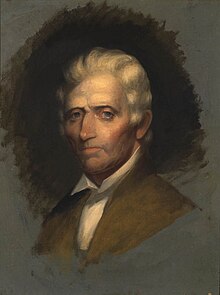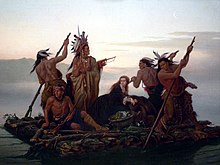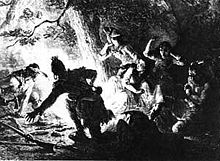Daniel Boone

Daniel Boone (born October 22, jul. / 2. November 1734 greg. In Birdsboro , Province of Pennsylvania ; † 26. September 1820 in Defiance , Missouri Territory ) was an American pioneer and hunter , inter alia, the Wilderness Road opened up and founded the town of Boonesborough , Kentucky .
Childhood and youth
Boone's parents, Quakers , emigrated from England in 1717 and settled in Pennsylvania . Probably on November 2, 1734 Daniel Boone was born in a log cabin in Birdsboro and grew up with ten siblings. Although he did not go to school, he learned to read, write and do arithmetic at home. He also learned skills such as riding, shoeing horses, tracking and hunting.
Two Boones siblings married outside the Quaker community, which aroused displeasure among neighbors. In 1750 the family decided to move south. In 1753 they settled in the Yadkin River valley on the western border of North Carolina . Daniel Boone felt very comfortable in his new home, roamed through the vast forests and sometimes shot a dozen deer in a single morning. He then used the afternoons to sell the skins in Salisbury .
After two years in the North Carolina wilderness, Boone first met an Indian . This was so angry with Boone's superior art of shooting that he threatened to scalp him .
In 1755 Boone served as a charioteer in the British forces under Major General Edward Braddock . The goal of the 1,400-strong troop was to take the French Fort Duquesne on the Ohio River . They were caught in a French ambush near the fort; half of the men died. Boone managed to separate his team from the car and flee.
Exploration of Kentucky and Tennessee


In 1756 Boone married his brother-in-law's sister, Rebecca Bryan, a neighbor from North Carolina's Yadkin Valley who had ten children over the years. The two settled in a log cabin on Bear Creek . As a result, Boone created a few fields, which he worked in spring and summer. In autumn he was driven into the wilderness of the Appalachians , where he hunted and set beaver traps throughout the winter. He was one of the first whites to venture into the Blue Ridge Mountains and the eastern Allegheny Mountains .
After conflicts between British settlers and Cherokee Indians in 1759, Boone served in the North Carolina militia during the Cherokee Uprising. His hunting expeditions deep into the Cherokee region behind the Blue Ridge Mountains separated him from his wife for about two years. It is reported that Rebecca assumed he was dead. She was dating Boone's brother Edward ("Ned"). The daughter Jemima (born 1762) is said to have emerged from the relationship. On his return, the story goes , his wife is said to have said, "You'd have better stayed at home and had it yourself." Boone was understanding and didn't blame Rebecca. Whatever the truth of the story, Boone raised Jemima like his own child. Boone's early biographers knew this story but did not publish it.
On May 1, 1769, Boone and five men went on a hunting tour to Kentucky . There were his brother-in-law John Stuart, the dealer John Finley, Joseph Holden, James Money and William Cool. They advanced as far as the Cumberland Mountains . Over the course of seven months, they hunted with great success in the Kentucky woods. On December 22, 1769, the group of Mounted Shawnee Indians was captured. A little later the Shawnee discovered their extensive fur warehouse, which they took over for themselves. Two days later they released the whites and advised them to stay away from their hunting grounds. Boone and his companions made their way back empty-handed. Along the way, Boone and his brother-in-law came across Boone's brother Squire and another man. Together they went hunting again. Squire made two trips to North Carolina and back, bringing home the booty and fetching new supplies. In March 1771, Daniel Boone also decided to return; he was again attacked by Indians who took all the booty and the horses from him.
After two years in North Carolina, Boone decided to settle permanently in Kentucky. The Boone family with their eight children and five other families set out in September 1773, but were attacked by Indians on the eastern approach to the Cumberland Mountains. Some men were killed, including Boone's son James. The women refused to continue, and the group returned to the Yadkin Valley.
Meanwhile, other settlers had come to Kentucky on arduous paths. Boone was commissioned in 1775 to pave a way through the Cumberland Mountains to Kentucky together with 30 loggers. After the group had been attacked a number of times by Indians, Boone had to use all his persuasiveness to drive the discouraged loggers on. They set up a base camp in Kentucky, after which Boone returned to North Carolina to lead more settlers. A branch called Boonesborough was quickly established near the base camp .
Fight against British and Indians
The American War of Independence broke out that same year . The British colonial troops gave their allied Indian tribes, including the Shawnee, Odawa and Miami , firearms and ammunition. The Indians who returned from Kentucky with scalps from settlers were rewarded. This caused panic among the settlers, and about half left Kentucky. During the continued fighting with the English and Indians, Boone also lost his second eldest son in one of the final battles of the Revolutionary War, the Battle of Blue Licks . In July 1776, Shawnee kidnapped Jemima, a daughter of Boone, among others. Daniel Boone and some men were able to catch up with the Indians after two days and free Jemima, Betsey and Fanny Callaway. James Fenimore Cooper's novel The Last of the Mohicans is based in part on this event.
In January 1778 Boonesborough threatened to run out of salt; Boone left with 30 men to fetch new salt from a mineral spring in central Kentucky. The group reached the spring unscathed and Boone set out to hunt. In February he was spotted and shot at by Shawnee warriors. Boone escaped behind a tree and put his rifle on the ground in front of him as a gesture of surrender. The Shawnee captured him and later his companions and took them to their camp on the Little Miami River in what is now the state of Ohio . The Shawnee were very proud to have captured the famous Ranger. Chief Black Fish adopted Boone as his brother and named him Big Turtle . Boone quickly adapted to Native American life but decided to flee when the Shawnee warriors intended to attack Boonesborough. He managed to escape, riding a horse to death and walking the final 160 miles to Boonesborough. There he was the only one in his family to find his daughter Jemima; his wife had returned to North Carolina because she no longer believed in his salvation. Boone urged the residents of the settlement to reinforce the palisades . In fact, they withstood the seven-day siege of the attackers - around 400 Shawnee warriors and twelve Canadian rangers - in early September 1778. If Boonesborough had fallen, the Americans would have lost the last settlement in the far west; so the defeat of the Shawnee was of great importance for the outcome of the American Revolutionary War.
Boone rode to North Carolina to see his family and brought them back to Boonesborough. The Shawnee attacks on Kentucky settlements continued in the following years. In August 1782, Boone headed a militia division that pursued the defended Shawnee. Boone feared an ambush but couldn't stop his men. Boone was right: In a short time, 60 men, including his son Israel, were killed by the Shawnee on the Blue Licks River . The death of Israel hit him very hard; he felt responsible for it because he had failed to hold the men back.
In 1782 Boone met the schoolteacher John Filson , who was writing a book about the settlement of the West and wanted to speak to Boone, among other things. Boone described his experiences very impressively. They met with great interest and were soon separated from Filsons book and translated into several languages. The publication of his adventures in "The Adventures of Colonel Daniel Boone" in 1784 by John Filson made him a mythical figure while he was still alive and immortalized as the epitome of the border guards and pioneer in American legendary culture . For example, his life served as a model for James Fenimore Cooper's leather socks Nathaniel Bumppo , who romanticized the figure as a natural man and Indian friend, in order to denounce the circumstances of the time.
Loss and a new beginning
In 1783 Boone and his family settled in Limestone on the Ohio River and built a trading post and tavern. He also worked as a surveyor and broker. Problems arose when he claimed land for his customers that had already been staked out for other settlers. More and more people thought he was a fraud; soon he had several lawsuits on his neck. To appease his dissatisfied clients, he gradually sold his own property to compensate them. He went back to hunting, but the game population had decreased significantly due to the increased population.
His son Daniel Morgan Boone met the Spanish Lieutenant Governor Z. Trudeau in 1798 , who invited the whole family to settle in the Missouri area. In 1799, the Boones accepted the invitation and left Kentucky. Daniel Boone gave the reason: “Too crowded! Too crowded! I need more elbow room. ” The Spanish in St. Louis welcomed him and gave him permission to settle west of the city. Later the famous trapper John Colter was to become his neighbor there. Two years later, Daniel Boone took the position of Judge and Commander of the Femme Osage District. As such, he took care of estates, notarized documents and judged crimes.
In October 1800, the Spanish sold the Louisiana Territory , which also included the territory of what would later become the State of Missouri, to the French, who in turn sold it to the United States three years later. The new rulers did not recognize the land donation by the Spaniards to the Boones; there was a legal process that lasted until 1814, a year after Rebecca Boone's death. Daniel Boone's claims were finally justified. A little later, three Kentucky men showed up claiming he owed them money. Daniel Boone, in turn, had to sell all of his land to please the three men. Only his children had their land. Almost 80-year-old Boone decided to go fur-hunting in the woods northwest. Soon his eyesight deteriorated and his rheumatism worsened. More and more often, Boone was forced to stay with his son Nathan, who lived with Defiance in the US state of Missouri.
Daniel Boone was happy with his life overall - and especially relieved that he had nowhere more debt. Towards the autumn of 1820 his health deteriorated sharply; on September 26, he died at the age of almost 86 in his son's house. Originally buried in Missouri, his bones were transferred to Frankfort , Kentucky, 25 years after his death , where he is now considered "the father of Kentucky".
Anecdotes

Many popular anecdotes have survived. His rifle was a Kentucky Long Rifle called the "Tick-Licker" . This tendency to personalize his weapon with a name can also be found in Karl May's stories, who knew Boone's memoir. The pioneer wore clothes made of deerskin with leather fringes - here, too, he set the tone for the image of the future generations of a trapper. Tradition has it that he is shown wearing a raccoon fur hat; in fact, Boone always wore the Quaker's black felt hat.
No matter how hopeless the situation was, Boone never gave up: once he admitted to having been “quite confused for several weeks” , referring to the phase after the death of his firstborn son.
reception
The band Pixies released a song called Daniel Boone in 2019 .
Single receipts
- ^ John Mack Faragher, Daniel Boone: The Life and Legend of an American Pioneer , p. 317.
- ↑ For the story of the birth of Jemima, see Faragher: Daniel Boone. Pp. 58-62. Faragher notes that Lyman Draper collected this information but did not include it in his manuscript.
literature
- Meredith Mason Brown: Frontiersman: Daniel Boone and the Making of America. Louisiana State University, Baton Rouge 2013, ISBN 978-0-8071-5445-8 .
- Michael Solka: Daniel Boone - ranger and explorer . In: Magazine for American Studies. No. 1, 2005 and No. 2, 2005.
- Michael A. Lofaro: Daniel Boone: An American Life. University Press of Kentucky, Lexington 2003, ISBN 0-8131-2278-3 .
- John Mack Faragher: Daniel Boone: The Life and Legend of an American Pioneer . Holt, New York 1992, ISBN 0-8050-1603-1 (English). (The standard scientific biography, examines both history and folklore)
- John Bakeless: The real leather sock . The life of Daniel Boone. from d. Engl. V. Karl Soll under co. Martha Slavik. List, Munich 1964. (Original title: Master of wilderness. )
- Henry Nash Smith: Virgin Land: The American West as Symbol and Myth. Chapter 5: Daniel Boone: Empire Builder or Philosopher of Primitivism? . 1950 (digitized version)
- Daniel Boon's expedition to Kentucky in Historisches portefeuille 1786. S. 31ff. (Digitized version)
Web links
- Literature by and about Daniel Boone in the catalog of the German National Library
- Detailed description of the history of Boone and his place of birth, engl. ( Memento from June 15, 2008 in the Internet Archive )
- Sharon Hernes Silverman: Daniel Boone Homestead: Pennsylvania trail of history guide. Stackpole Books, Mechanicsburg, PA 2000, ISBN 0-8117-2732-7 , page 8
| personal data | |
|---|---|
| SURNAME | Boone, Daniel |
| BRIEF DESCRIPTION | American pioneer and explorer |
| DATE OF BIRTH | November 2, 1734 |
| PLACE OF BIRTH | Birdsboro , Pennsylvania |
| DATE OF DEATH | September 26, 1820 |
| Place of death | Defiance , Missouri |




